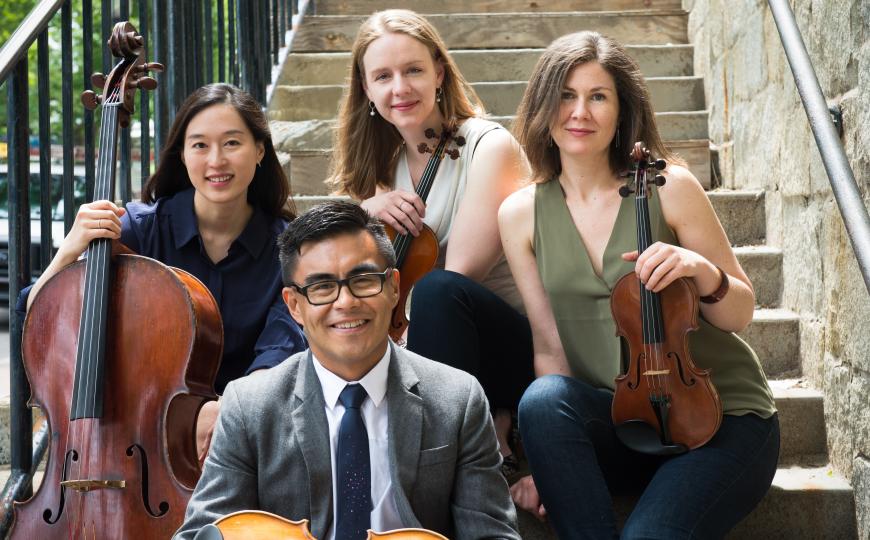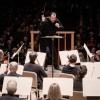
Every two years, the Rubin Institute for Music Criticism convenes in San Francisco, teaching music students across the U.S. about music journalism. SF Classical Voice has partnered with the Rubin Institute to give the program’s top writers more experience in the field with an internship. This year’s Rubin winners, Emery Kerekes and Lev Mamuya, will be with SFCV for six months, reporting from New York and Boston, respectively.
In its recent concert “Sounds From the Past,” the Arneis Quartet combined two works that examine history. But as composers recall history, it demonstrates both their nostalgia and their forward-thinking vision. Beethoven’s Op. 130 String Quartet transforms a variety of 18th-century forms into new shapes; Yessori, by the contemporary South Korean composer Soo Yeon Lyuh, draws from Korean folk traditions to create a distinctive idiom.
In devising the evening’s 10th-anniversary program (long postponed by COVID), the Arneis Quartet had cause to reflect on its own history as well. Like Beethoven and Lyuh, Arneis’s members considered some of the music that has shaped them while also modernizing their voice for the contemporary moment. They write in their printed program that “supporting our fellow composers became one of Arneis’s new visions during the pandemic.”

On Friday evening, the more familiar side of the group’s dual focus shone brightly. There is, as any quartet musician might know, a special joy to playing Beethoven’s notoriously thorny late quartets with trusted collaborators, which was clearly audible on Friday. But in its new extension toward contemporary repertoire, the group was less convincing. Its rendition of Yessori (programmed in place of Haydn’s “Rider” Quartet [Op.74, No.3], which the players had initially selected pre-COVID) was less full-throated than its pairing.
Yessori, commissioned for the Kronos Quartet’s “50 for the Future” project as a recomposition of a previous work for the haegeum (a bowed Korean string instrument), is highly expressive, brilliantly orchestrated for string quartet, and deserves deep examination and frequent performance. The piece is written around a pentatonic scale in which all five of the central pitches are moved away from Western scale referents (according to Lyuh, the tuning should feature “a wider interval range for note relationships than is customary in Western tuning schemes”). The work is characterized by tense tones that groan and swell suddenly, whimpering grace-note gestures, and dance-like percussion (the cellist is asked to play a small, metal percussion instrument in the piece’s final section).
On Friday, violist Daniel Doña sounded especially at home in this harmonic world in his opening solo and frequent interludes. But all the players could have leaned more assertively into their altered tones in the heat of their swells. And though the ensemble did well to find different colors of tension in their sound, the piece’s overall dynamic story displayed insufficient variation — it became difficult at times for listening ears to discern high points and low points during long stretches of tutti playing.
As they turned toward the Beethoven, however, there was no doubt that the players were experienced guides. Each member’s deep understanding of the work’s motifs and themes was on show. As with many of Beethoven’s seminal works, much of Op. 130 takes simple thematic material and, through invention and a multitude of permutations, makes it extraordinary. The piece also calls for virtuosity, which the group displayed in spades, whether in violinist Heather Braun’s heroic upright forte in the Presto movement or cellist Agnes Kim’s articulate and cultured basslines in the piece’s dance movements.
The musicians’ performance of the closing Grosse Fuge, offered in place of the more commonly performed replacement Finale, was no less impressive. Sitting in First Church Boston’s sanctuary, one of the city’s criminally underappreciated Brutalist enclaves, it was hard to resist drawing auric parallels between the guiding principles of Brutalism and late Beethoven. Both are obsessed with form and the history of form. Both, when executed well, take forms we thought we knew (be they a church or a fugue) and render them modern and beautiful (if bizarre to some).
Playing something beautiful is an elusive enough quest for a quartet. Trying to say something new, through either historical or contemporary repertoire, is an additional challenge. “Sounds From the Past” showed four players wrestling with many of the same questions as their peers in pursuit of both these goals. The Arneis Quartet has more than proven itself a capable ensemble in both these arenas. As its scope widens over the next decade, one hopes that Arneis will love and live in music like Lyuh’s, just as they have Beethoven’s, so that the voices of fellow composers speak vitally and vibrantly.




